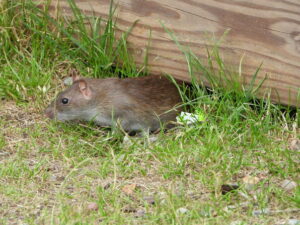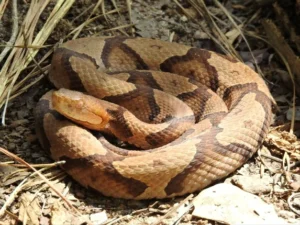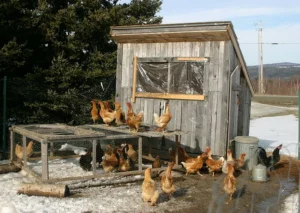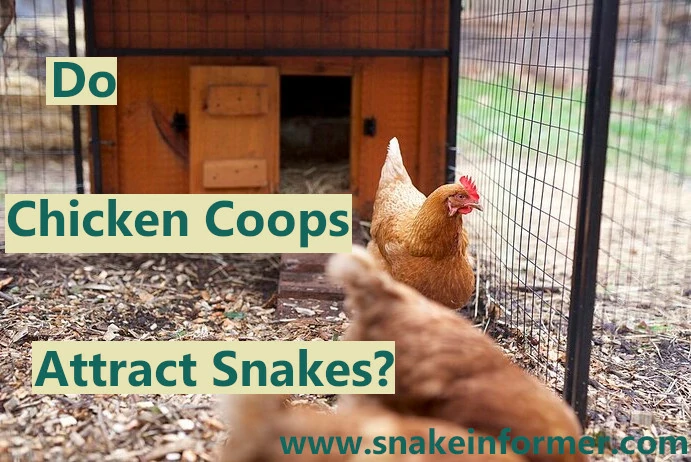Snakes are often drawn to places where they hide, stay warm, and easily find food.
Chicken coops can attract snakes because they offer food, shelter, and warmth, making them ideal hangouts for certain snake species.
That said, snakes that are drawn to your chicken coop are rarely attracted by the chickens themselves.
Instead, they are usually attracted by rodents like mice and rats, which are often abundant around chicken coops.
Some snake species could also be looking for eggs, even baby chicks.
5 Reasons Why Snakes Are Attracted to Chicken Coops
The truth is, snakes are rarely attracted to chicken coops because of the chickens themselves – at least not at first.
Instead, they’re usually lured in by secondary factors.
Here are 5 reasons why snakes may be drawn to your chicken coop.
1. Abundance of Rodents
One of the most common reasons snakes are drawn to chicken coops is the presence of rodents, such as mice and rats.
Chicken coops, especially when not properly maintained, offer an ideal environment for rodents to thrive.
Loose or spilled chicken feed is great food for mice, and accumulated droppings, nesting material, and warm bedding provide shelter and nesting sites.
Once rodents move in, snakes are not far behind.

Many snake species (such as rat snakes, king snakes, and corn snakes) primarily rely on small mammals for food.
These snakes use their sense of smell, as well as their vision to detect and hunt for prey. In this case, the prey may be in or near your coop.
If a snake enters your chicken coop and finds lots of rodents, it is unlikely to leave as long as it has food.
2. The Presence of Eggs
Another thing that attracts snakes to chicken coops is the presence of eggs.
Many snake species (for example, rat snakes, and king snakes) are known to eat whole chicken eggs with surprising efficiency.
Chicken eggs left unattended in the coop are defenseless, making them an ideal food source for snakes.
If eggs are not collected regularly, they can attract hungry snakes looking for a meal.
Once a snake learns that a coop provides a reliable supply of eggs, it may return repeatedly, even after being removed.
3. The Presence of Chicks
While most adult chickens are too big for the average snake to eat, chicks are defenseless and enticing prey for many snake species.
Snakes such as gopher snakes, rat snakes, bull snakes, and even venomous species like copperheads or young rattlesnakes can and do prey on small birds when given the opportunity.

Snakes are very flexible and can squeeze through smaller holes than most people think.
A snake can easily slither into a coop unnoticed, especially at night, when both chicks and keepers are inactive.
Once inside a coop, a single snake can eat multiple chicks in one night and leave little evidence behind.
4. Chicken Coops Provide Ideal Shelter
Chicken coops typically have many hidden spaces that make excellent places for snakes to rest, hide, or even nest.
In the wild, snakes seek out natural shelters like rock crevices or abandoned burrows.
Structures like chicken coops often mimic those natural hideouts.
This makes them attractive shelters for snakes.
Once inside the coop, snakes tend to gravitate towards dark, hidden areas such as:
- Dark corners behind nesting boxes
- Under raised floorboards or roosting platforms
- Beneath piles of straw, hay, or wood shavings
- Inside feed storage bins, if not properly sealed
In many cases, a snake may remain hidden in or around a coop for days, only coming out occasionally to hunt or explore.
This means you might not even realize it’s there until chicks or eggs go missing.
Also, coops located near wooded areas, tall grass, or water sources are even more likely to attract snakes.
These natural environments act as extensions of a snake’s territory. The coop simply becomes another stop in its range.
5. Chicken Coops Provide Warmth
Another reason snakes are drawn to chicken coops is the warmth they provide. This is especially true during cooler seasons or sudden weather changes.
Like all reptiles, snakes are cold-blooded (ectothermic) animals.
This means they cannot internally regulate their body temperature. Instead, their body temperature changes with the temperature in their surroundings.
In the wild, snakes bask on sun-heated rocks or hide in underground burrows to escape low temperatures.

But in urban environments, they’re drawn to artificial sources of heat, and a chicken coop is an ideal option.
- Body Heat from Chickens. Chickens generate considerable body heat. A flock housed in an enclosed space can significantly raise the temperature inside a coop. For snakes seeking warmth, this natural heat source is very appealing.
- Insulation and Heat Retention. Many coops are built with insulated walls, thick wooden structures, and layers of bedding, all of which trap and retain heat. This provides snakes with an ideal place to curl up.
Snake Species Commonly Found Around Coops
Depending on where you live, many snake species can be attracted to your chicken coop.
Here are 6 snakes that are commonly found near chicken coops.
| Snake Species | What Attracts Them |
|---|---|
| Rat Snake | Eggs, rodents |
| King Snake | Rodents, eggs |
| Gopher Snake | Rodents |
| Corn Snake | Rodents |
| Copperhead | Rodents, chicks |
| Rattlesnake | Rodents, chicks |
| Water Moccasin | Rodents |
7 Tips to Keep Snakes Away From Your Chicken Coop
If you want to stop snakes from coming in or near your chicken coop, you have to make the area less attractive to them.
Here are a number of things you can do to keep snakes from your coop.
1. Keep Mice and Other Small Animals Away
One of the easiest ways of keeping snakes away is to get rid of the “snake food” (prey animals) you have in or around your chicken coop.
You can do this by quickly cleaning up spilled feed, storing feed in metal containers with tight-fitting lids, and eliminating rodent hiding spots.
Also, get rid of trash piles outside the chicken coop, or anything that may attract rodents or insects.
In essence, make sure there is nothing in or around your coop that can attract mice or other animals that snakes prey on.
2. Seal All Entryways
Block off as many possible entryways to your coop as possible, to reduce the chance of a snake slithering inside.
Screen all outside vents, seal cracks and holes around the foundation, and make sure doors and windows fit tightly.
Snakes can squeeze through spaces only a few inches wide, so even tiny holes should be blocked off.
3. Collect Eggs Daily
Leaving eggs uncollected increases the risk that their scent will attract snakes from surrounding areas.
Make it a routine to check nesting boxes at least once a day, and more often if you have a large flock or during peak laying season.
4. Keep Your Grass Short
Tall grass provides the perfect cover for snakes to hide in. It also attracts mice, and other small animals that garter snakes prey on.
Keep your grass, and other vegetation around the coop short. This will discourage snakes from coming near, and and into your coop.
It will also make it easy to spot the snakes that do end up around your coop so you can get rid of them.
5. Clear Dead Leaves and Other Dead Vegetation
Snakes love to hide under dead logs and leaf litter on the ground.
Be sure to clear dead leaves or other vegetation around your coop
Getting rid of these will keep snakes away because they will have fewer places to hide.
6. Keep Firewood, Compost Piles, and Other Types of Debris Away From Your Coop
Snakes love to hide in well-covered areas outside. Compost piles or stacks of firewood and lumber are the perfect places for garter snakes to hide.
If these are kept close to the coop, snakes can easily make their way inside.
Store firewood, lumber, and other piles of debris away from your coop.
7. Be Vigilant During the Warm Seasons of the Year
Snakes and other reptiles are most active when the temperatures are warm.
Be alert during this time of the year and watch for any snakes that may end up in your yard, so they do not get inside the coop.
Conclusion
Many chicken owners are alarmed to discover a snake curled up in their coop.
However, snakes will rarely enter a chicken coop with the intention of causing harm.
Instead, they often end up inside the coop in search of food, shelter, or even by accident.
Featured image credit: Karl Thomas Moore, CC BY-SA 4.0., via Wikimedia Commons
Hi, my name is Ezra Mushala, i have been interested animals all my life. I am the main author and editor here at snakeinformer.com.

